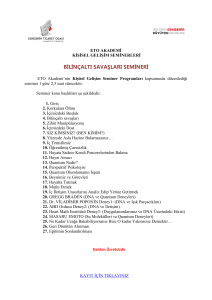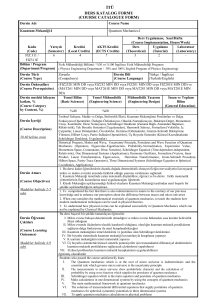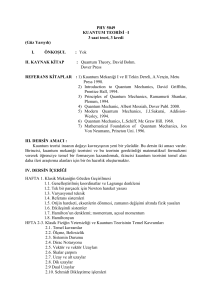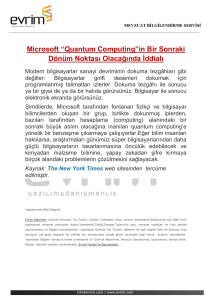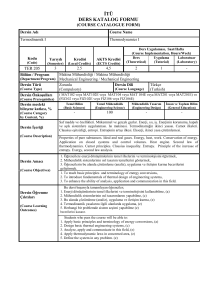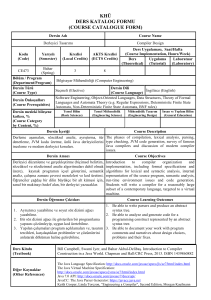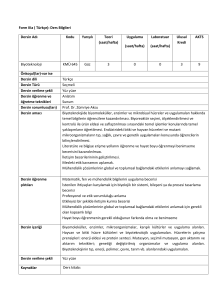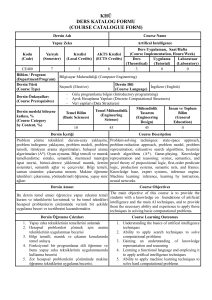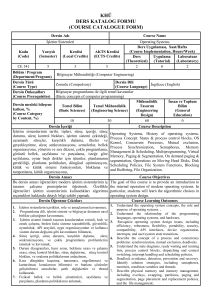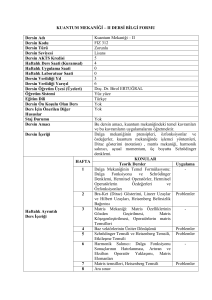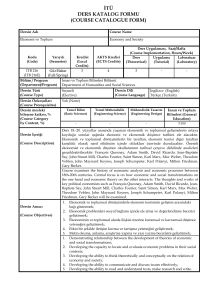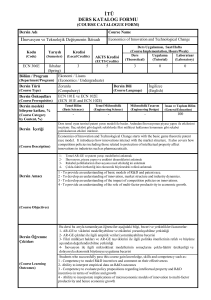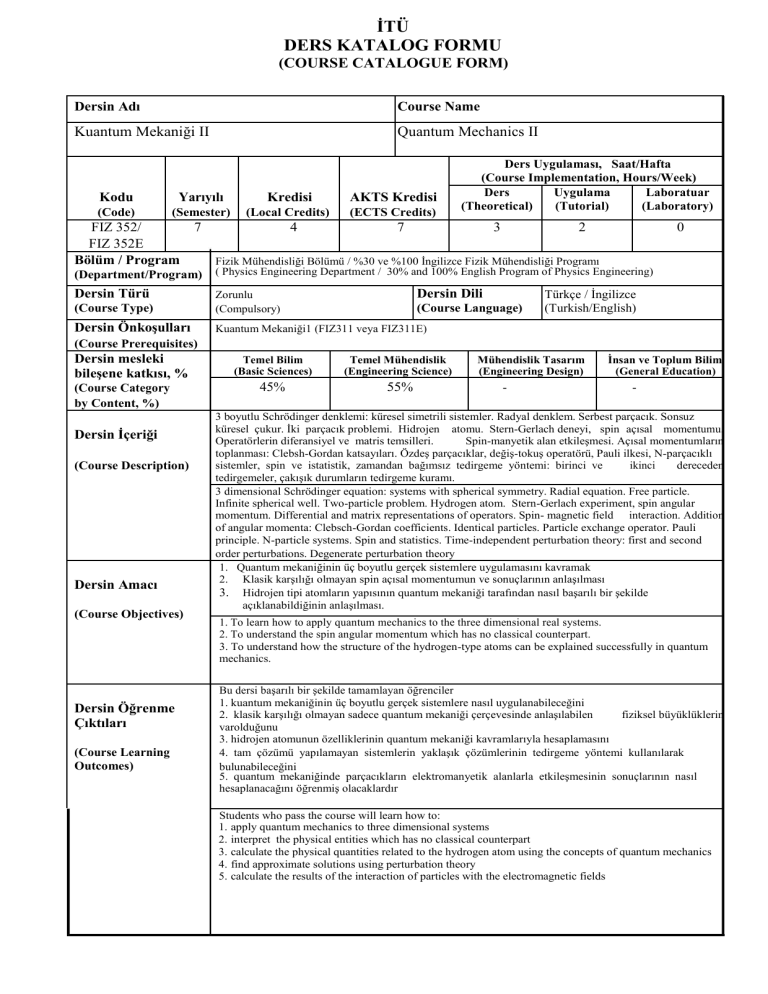
İTÜ
DERS KATALOG FORMU
(COURSE CATALOGUE FORM)
Dersin Adı
Course Name
Kuantum Mekaniği II
Quantum Mechanics II
Kodu
Yarıyılı
Kredisi
AKTS Kredisi
(Code)
(Semester)
(Local Credits)
(ECTS Credits)
Ders Uygulaması, Saat/Hafta
(Course Implementation, Hours/Week)
Ders
Uygulama
Laboratuar
(Theoretical)
(Tutorial)
(Laboratory)
FIZ 352/
7
4
7
3
2
FIZ 352E
Bölüm / Program
Fizik Mühendisliği Bölümü / %30 ve %100 İngilizce Fizik Mühendisliği Programı
0
(Department/Program)
( Physics Engineering Department / 30% and 100% English Program of Physics Engineering)
Dersin Türü
(Course Type)
Zorunlu
(Compulsory)
Dersin Önkoşulları
Kuantum Mekaniği1 (FIZ311 veya FIZ311E)
Dersin Dili
(Course Language)
Türkçe / İngilizce
(Turkish/English)
(Course Prerequisites)
Dersin mesleki
bileşene katkısı, %
(Course Category
by Content, %)
Dersin İçeriği
(Course Description)
Dersin Amacı
(Course Objectives)
Dersin Öğrenme
Çıktıları
(Course Learning
Outcomes)
Temel Bilim
(Basic Sciences)
Temel Mühendislik
(Engineering Science)
45%
55%
Mühendislik Tasarım
(Engineering Design)
-
İnsan ve Toplum Bilim
(General Education)
-
3 boyutlu Schrödinger denklemi: küresel simetrili sistemler. Radyal denklem. Serbest parçacık. Sonsuz
küresel çukur. İki parçacık problemi. Hidrojen atomu. Stern-Gerlach deneyi, spin açısal momentumu.
Operatörlerin diferansiyel ve matris temsilleri.
Spin-manyetik alan etkileşmesi. Açısal momentumların
toplanması: Clebsh-Gordan katsayıları. Özdeş parçacıklar, değiş-tokuş operatörü, Pauli ilkesi, N-parçacıklı
sistemler, spin ve istatistik, zamandan bağımsız tedirgeme yöntemi: birinci ve
ikinci
dereceden
tedirgemeler, çakışık durumların tedirgeme kuramı.
3 dimensional Schrödinger equation: systems with spherical symmetry. Radial equation. Free particle.
Infinite spherical well. Two-particle problem. Hydrogen atom. Stern-Gerlach experiment, spin angular
momentum. Differential and matrix representations of operators. Spin- magnetic field interaction. Addition
of angular momenta: Clebsch-Gordan coefficients. Identical particles. Particle exchange operator. Pauli
principle. N-particle systems. Spin and statistics. Time-independent perturbation theory: first and second
order perturbations. Degenerate perturbation theory
1. Quantum mekaniğinin üç boyutlu gerçek sistemlere uygulamasını kavramak
2. Klasik karşılığı olmayan spin açısal momentumun ve sonuçlarının anlaşılması
3. Hidrojen tipi atomların yapısının quantum mekaniği tarafından nasıl başarılı bir şekilde
açıklanabildiğinin anlaşılması.
1. To learn how to apply quantum mechanics to the three dimensional real systems.
2. To understand the spin angular momentum which has no classical counterpart.
3. To understand how the structure of the hydrogen-type atoms can be explained successfully in quantum
mechanics.
Bu dersi başarılı bir şekilde tamamlayan öğrenciler
1. kuantum mekaniğinin üç boyutlu gerçek sistemlere nasıl uygulanabileceğini
2. klasik karşılığı olmayan sadece quantum mekaniği çerçevesinde anlaşılabilen
fiziksel büyüklüklerin
varolduğunu
3. hidrojen atomunun özelliklerinin quantum mekaniği kavramlarıyla hesaplamasını
4. tam çözümü yapılamayan sistemlerin yaklaşık çözümlerinin tedirgeme yöntemi kullanılarak
bulunabileceğini
5. quantum mekaniğinde parçacıkların elektromanyetik alanlarla etkileşmesinin sonuçlarının nasıl
hesaplanacağını öğrenmiş olacaklardır
Students who pass the course will learn how to:
1. apply quantum mechanics to three dimensional systems
2. interpret the physical entities which has no classical counterpart
3. calculate the physical quantities related to the hydrogen atom using the concepts of quantum mechanics
4. find approximate solutions using perturbation theory
5. calculate the results of the interaction of particles with the electromagnetic fields
Ders Kitabı
Introduction to Quantum Mechanics, D.J. Griffiths, Pearson 2005 Second Edition
(Textbook)
Diğer Kaynaklar
1. Quantum Physics, Stephen Gasiorowicz, Wiley 2003 Third Edition
2. Kuantum Mekaniği 1-2, Tekin Dereli, Abdullah Verçin, Metu Press 2000
3. Principles of Quantum Mechanics, H.C. Ohanian, Prentice Hall, 1990
4. Principles of Quantum Mechanics, Ramamurti Shankar, Plenum Press,1980.
(Other References)
Ödevler ve Projeler
İki haftada bir ödev verilir (en az).
(Homework & Projects
Homework assignments are given once in two weeks (minimum).
Laboratuar Uygulamaları
-
(Laboratory Work)
-
Bilgisayar Kullanımı
-
(Computer Use)
-
Diğer Uygulamalar
İki haftada bir kısa sınav yapılır (en az).
(Other Activities)
Quizzes are given once in two weeks (minimum).
Başarı Değerlendirme
Sistemi
Faaliyetler
(Activities)
Yıl İçi Sınavları
(Midterm Exams)
Kısa Sınavlar
(Quizzes)
Ödevler
(Homework)
Projeler
(Projects)
Dönem Ödevi/Projesi
(Term Paper/Project)
Laboratuar Uygulaması
(Laboratory Work)
Diğer Uygulamalar
(Other Activities)
Final Sınavı
(Final Exam)
(Assessment Criteria)
Adedi
(Quantity)
2
Değerlendirmedeki Katkısı, %
(Effects on Grading, %)
%20
7
%30
7
%10
1
%40
DERS PLANI
Hafta
1
2
3
4
5
6
7
8
9
10
11
12
13
14
Konular
Üç boyutlu Schrodinger denklemi, üç boyutlu kutudaki parçacık
Küresel simetrili sistemler, açısal momentum
Hidrejen atomu
Stern-Gerlach deneyi, spin açısal momentum
Spin-manyetik alan etkileşmesi
Açısal momentumun toplanması, Clebsch-Gordon katsayıları (birinci vize)
Çok parçacıklı sistemler
Spin ve istatistik, bozonlar fermiyonlar
Tedirgeme yöntemi genel özellikler
Hidrojen atomunun ince yapısı
Hidrojen atomunun aşırı ince yapısı (ikinci vize)
Stark etkisi
Zeeman etkisi
Quantum dolanıklık
Dersin
Çıktıları
1
1
3
2
5
1
2
2
4
1-4-5
1-4-5
4-5
4-5
2
COURSE PLAN
Weeks
1
2
3
4
5
6
7
8
9
10
11
12
13
14
Topics
Three dimensional Schrodinger equation, particle in a three dimensional box
Spherically symmetric systems, angular momentum
Hydrogen atom
Stern-Gerlach experiment, spin angular momentum
Spin-magnetic field interaction
Addition of angular momenta, Clebsch-Gordon coefficient (first midterm)
Many particle systems
Spin and statistics, bosons fermions
Perturbation theory (general properties)
Fine structure of the hydrogen atom
Hyperfine structure of the hydrogen atom (second midterm)
Stark effect
Zeeman effect
Quantum entanglement
Course
Outcomes
1
1
3
2
5
1
2
2
4
1-4-5
1-4-5
4-5
4-5
2
Dersin Fizik Mühendisliği Programıyla İlişkisi
Katkı
Seviyesi
1 2
3
X
Programın mezuna kazandıracağı bilgi ve beceriler (programa ait çıktılar)
a
b
c
d
e
f
g
h
i
j
k
Matematik, Bilim ve Mühendislik bilgilerini uygulayabilme
Data analizi yapabilmek ve deney tasarlayıp yürütebilmek
İhtiyacı karşılayacak sistem, bileşen ve süreçleri dizayn edebilme
Disiplinler arası çalışma gerçekleştirebilme
Mühendislik problemlerini belirleyebilme, formüle edebilme ve çözebilme
Mesleki ve ahlaki sorumluluklarını anlayabilme
Etkili bir şekilde iletişim kurabilme
Global/sosyal anlamda mühendislik çözümlerinin etkilerini anlayabilme
Hayat boyu öğrenimin önemini kavrayabilme ve benimseme
Modern meselelerle ilgili bilgi sahibi olabilme
Mühendislik uygulamaları için gerekli modern mühendislik araçlarını, tekniklerini
kullanabilme
X
X
X
X
1: Az, 2. Kısmi, 3. Tam
Relationship between the Course and Physics Engineering Curriculum
Program Outcomes
a
b
c
d
e
f
g
h
i
j
k
Ability to Apply Knowledge of Mathematics, Science, and Engineering
Ability to Design and Conduct Experiments, as well as to Analyze and Interpret Data
Ability to Design a System, Component, or Process to Meet Desired Needs
Ability to Function on Multi-Disciplinary Teams
Ability to Identify, Formulate, and Solve Engineering Problems
Understanding of Professional and Ethical Responsibility
Ability to Communicate Effectively
Broad Education Necessary to Understand the Impact of Engineering Solutions in a
Global/Societal Context
Recognition of the Need For, and an Ability to Engage in Life-Long Learning
Knowledge of Contemporary Issues
Ability to Use the Techniques, Skills, and Modern Engineering Tools Necessary for
Engineering Practice
Level of
Contribution
1 2
3
X
X
X
1: Little, 2. Partial, 3. Full
Düzenleyen (Prepared by)
Tarih (Date)
03.06.2010
İmza (Signature)
X
X

